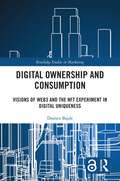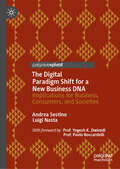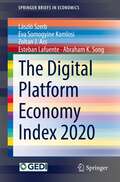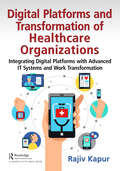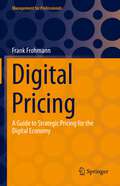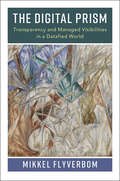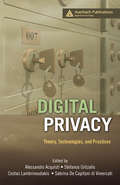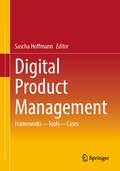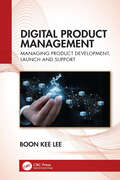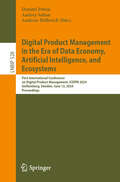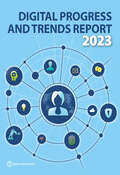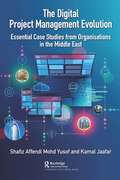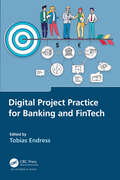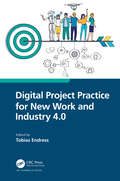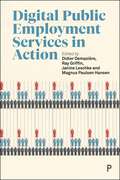- Table View
- List View
Digital Opportunities in African Businesses (International Finance Corporation Research Series)
by Marcio CruzAdoption of digital technologies is widely acknowledged to boost productivity and employment, stimulate investment, and promote growth and development. Africa has already benefited from a rapid diffusion of information and communications technology, characterized by the widespread adoption of mobile phones. However, access to and use of digital technology among firms is uneven in the region, varying not just among countries but also within them. Consequently, African businesses may not be reaping the full potential benefits offered by ongoing improvements in digital infrastructure. Using rich datasets, Digital Opportunities in African Businesses offers a new understanding of the region’s incomplete digitalization—namely, shortfalls in the adoption and effective use of digital technology by firms to perform productive tasks. The research presented here also highlights the challenges in addressing incomplete digitalization, finding that the cost of machinery, equipment, and software, as well as the cost of connectivity to the internet, is significantly more expensive in Africa than elsewhere. Digital Opportunities in African Businesses outlines ways in which the private sector, with support from policy makers, international institutions, and regulators, can help bring down these costs, stimulating more widespread digitalization of the region’s firms, thereby boosting productivity and, by extension, economic development. This book will be relevant to anyone with an interest in furthering digitalization across Africa. ------------------------------------------- It is clear that new digital technologies are opening up new opportunities for economic growth. But will African firms be able to take advantage of them? If so, how? To gain traction on these questions, we first need careful empirical research on what firms are currently doing, and rigorous thinking about what is getting in the way of greater adoption. This book delivers on both dimensions. It marries carefully collected new evidence with thoughtful, no-nonsense analysis of firm behavior and how markets are evolving. It is highly recommended reading for researchers and policymakers alike. — Eric Verhoogen, Professor of International and Public Affairs and of Economics, Columbia University
Digital Oratory as Discursive Practice: From the Podium to the Screen (Postdisciplinary Studies in Discourse)
by Fiona Rossette-CrakeThis book offers an appraisal of oratory, old and new, relating former discourse practice to a specific sub-set of contemporary, digital practices. The author explores the interface between language and society, providing an interdisciplinary study at the crossroads of discourse, linguistics, communication and rhetoric. The comparisons she draws are particularly pertinent in light of the steep rise in presentations given during video-conferences, webinars, and other online events during the COVID-19 pandemic, an event which accelerated previous moves towards digital communication and which is likely to have a long-term impact on communication styles. This book will be of interest to academics and students in fields including discourse analysis, applied linguistics, communication studies, digital studies and business studies.
Digital Ownership and Consumption: Visions of Web3 and the NFT Experiment in Digital Uniqueness (Routledge Studies in Marketing)
by Domen BajdeThis book ventures into new and often-contested terrains of NFT consumption to explore what they reveal about digital ownership. Is there a place for ownership in the digital world? What does it mean to possess something digital? What is the role of uniqueness in digital ownership? How do digital things come to be unique? The author undertakes this journey by drawing on consumption research, sociological, philosophical and law literature, and by paying close attention to what NFT consumers and industry insiders have to say about digital ownership.This book comprises three parts exploring three overarching ideas: (1) that the NFT experiment helps shake up entrenched assumptions about ownership, thus opening new avenues for thinking and exploring digital ownership and its role in society; (2) that ownership is not just a bundle of legal rights or a social-technical arrangement, but also a powerful force in, and outcome of, how we imagine society and the future; (3) that the NFT experiment invites us to more closely examine the relation between digital ownership and uniqueness and offers valuable insights into contemporary society of singularities.While the primary intended audience for this book are consumption scholars and students, many other readers interested in digital ownership, digital markets and Web3 will find it interesting and relevant.
Digital Painting and Rendering for Theatrical Design: Using Digital Tools to Create Scenic, Costume, and Media Renderings
by Jen GilletteDigital Painting and Rendering for Theatrical Design explores the tools and techniques for creating dazzling, atmospheric, and evocative digitally painted renderings for scenic, costume, and projection/integrated media design. By focusing on technique rather than the structure of a particular software, this book trains theatrical designers to think and paint digitally, regardless of the software or hardware they choose. The text begins with the construction of the artist’s physical and digital workspace, then delves into an explanation of tool functionality, technique-building exercises, and examples from professional theatrical designers to help contextualize the concepts presented. Each chapter gradually progresses in complexity through skill-building exercises and advanced tool functionality, covering concepts like brush construction, various forms of masking, and layer interaction. The book explores various methods of constructing a digital rendering, including producing digital paintings that look like traditional media and photo bashing – the practice of using extant photographs to create a collaged image. Concepts are contextualized throughout the text using illustrations, quotes, and interviews with working professional designers. This beautifully illustrated guide is written for professional theatrical artists, students of theatrical design, and other visual artists looking to broaden their digital painting skillset.
The Digital Paradigm Shift for a New Business DNA: Implications for Business, Consumers, and Societies
by Andrea Sestino Luigi NastaThis book explores the crucial role of “remembering” the fundamental purpose of firms’ existence especially in today’s context: Meeting individuals’ and societal needs. Through seven chapters, the book shed light on the issue of the integration of new technologies within value propositions, by examining their positive impacts on both individual and societal wellbeing. Beginning with an examination of evolving consumers expectations and the core mission of companies, it proceeds through a rigorous analysis of digital technologies impact on wellbeing. Chapters intricately explore themes such as the adoption of mobile health technologies, the role of AI in shaping positive emotions, and the transformative potential of gamification in cultural heritage experiences. Nonetheless, a qualitative examination of sustainable digital business models offering practical insights into fostering wellbeing through technological innovation is also presented. Ultimately, the book culminates in a holistic discussion on integrating digital technologies to enhance collective wellbeing, offering comprehensive insights and conclusive trajectories for future considerations. The book also offers some Case Studies and specialists’ perspectives exploring real success stories deriving from firms, managers, scholars and practitioners committed to the mission of positively integrating managing new technologies. With a preface by Prof. Yogesh Dwivedi, and Prof. Paolo Boccardelli.
Digital Participation and Collaboration in Architectural Design
by Richard LaingThe emergence of new digital and visualisation technologies in recent years has led to rapid changes in the field of architecture. Current drives to incorporate building information modelling as a part of architectural design are giving way to the increased use of IT and visualisation in architectural design, user participation and group collaboration. As digital methods become more mainstream, Digital Participation and Collaboration in Architectural Design provides an accessible and engaging introduction to this emerging subject. Supported by selected examples from research and practice, the book offers an overview of theories, techniques and approaches which readers can apply in their own work. In doing so, it shows how these techniques can influence communication, debate and understanding and encourages readers to see familiar buildings from original and unusual perspectives. An ideal starting point for anyone interested in the application of digital techniques, the book will help students and professionals in architectural design and digital architecture to understand and embrace new technologies.
Digital Peripheries: The Online Circulation of Audiovisual Content from the Small Market Perspective (Springer Series in Media Industries)
by Petr Szczepanik Pavel Zahrádka Jakub Macek Paul StepanThis is an open access book. Media industry research and EU policymaking are predominantly tailored to large (and, in the latter case, Western) European markets. This open access book addresses the specific qualities of smaller media markets, highlighting their vulnerability to global digital competition and outlining survival strategies for them. New online distribution models and new trends in the consumption of audiovisual content are limited by, and pose new challenges for, existing audiovisual business models and their legal framework in the EU. The European Commission’s Digital Single Market (DSM) strategy, which was intended e.g. to remove obstacles to the cross-border distribution of audiovisual content, has triggered a heated debate on the transformation of the existing ecosystem for European screen industries. While most current discussions focus on the United States, Western Europe, and the multinational giants, this book approaches these industry trends and policy questions from the perspective of relatively small and peripheral (in terms of their population, language, cross-border cultural flows, and financial and/or symbolic capital) media markets.
Digital Personal Branding: Über den Mut, sichtbar zu sein. Ein Guide für Menschen und Unternehmen.
by Marina ZayatsDas Buch zeigt anwendungsnah, warum Digital Personal Branding ein unerlässliches Werkzeug für die Karriere ist und warum auch Unternehmen die Digital Personal Brand ihrer Mitarbeiter fördern sollten. Die Autorin erklärt entlang einer Personal-Branding-Roadmap, wie man seine Positionierung erarbeitet und diese anschließend durch vielfältige Möglichkeiten sichtbar macht. Anstatt einer reinen Selbstdarstellung liegt der Fokus jedoch immer auf dem eigenen Wertbeitrag.Im zweiten Teil des Buches geht es darum, wie Unternehmen davon profitieren, wenn sie ihre Mitarbeiter beim Aufbauen ihrer Digital Personal Brand unterstützen. Sei es im Vertrieb (Social Selling), Recruiting, in der Unternehmenskommunikation oder im Rahmen von Change-Projekten (Corporate Influencership).Experten aus der Praxis geben in kurzen Gastbeiträgen und Interviews einen Einblick in ihre Erfahrungen und stellen praxisnahe Übungen und Tipps vor. Für CEO’s, Gründer, Selbstständige ebenso wie für Angestellte ein geeigneter Leitfaden, um die Chancen der eigenen Personal Brand zu erkennen und zu nutzen.
The Digital Platform Economy Index 2020 (SpringerBriefs in Economics)
by Zoltan J. Acs László Szerb Esteban Lafuente Eva Somogyine Komlosi Abraham K. SongThis book presents the 2020 Digital Platform Economy Index (DPE Index). The DPE Index integrates two separate but related literatures on ecosystems, namely, the digital ecosystem and the entrepreneurial ecosystem. This new framework situates digital entrepreneurship within the broader context of users, platforms, and institutions, such that two biotic entities (users and agents) actuate individual agency, and two abiotic components (digital infrastructure and digital platforms) form the external environment. The DPE Index framework includes 12 pillars that integrate the digital and the entrepreneurship ecosystems. Here, the authors report on the DPE Index, the four sub-indices, and the 12 pillar values for 116 countries as well as provide a cluster analysis based on the 12 pillars.
Digital Platforms and Transformation of Healthcare Organizations: Integrating Digital Platforms with Advanced IT Systems and Work Transformation
by Rajiv KapurCOVID-19 accelerated healthcare’s transition towards digital technology since it helped expand the capacity of healthcare organizations (HCOs) through extended patient access and isolation. In addition to HCOs, this transition was adopted by other participants in the healthcare ecosystem, such as independent digital health platform (DHP) vendors, self-insured employers, drug chains/pharmacy benefit managers, and insurance companies. It was not long before independent DHPs, payers, and self-insured employers realized the value of digital technology, so they increased their commitment towards this transition. The goal of this book is to help HCOs understand, prepare, implement, and leverage digital transformation. The book opines that, to be successful, digital transformation must be led and supported by senior management. Equally important is the cultural transformation of HCOs towards successful change management, which requires an evolutionary approach to continuous process improvements of increasing scope and complexity. Next, HCOs must generate a comprehensive digital transformation roadmap that aligns with their strategic plan for enhancing clinical and related capabilities while improving patient engagement. To accomplish their digital transformation, HCO management and key stakeholders must comprehend and meet prerequisite requirements for: digital health platforms, advanced information technology, and work transformation methodologies. DHPs, and associated hardware and software complements, form the foundation of digital health technologies prevalent in modern-day healthcare and have gained increasing importance since COVID-19. Advanced information technology includes concepts vital to healthcare transformation such as EHRs, interoperability, big data, artificial intelligence, natural language processing, data security, and privacy. Lastly, work transformation methodologies address work redesign that incorporates different levels of process improvements and phases of digital transformation, lean/six sigma, agile methodologies, and human factors engineering to ensure well-designed interfaces for care providers and patients. The overarching goal of this book is to provide a roadmap for US healthcare towards an organized digital transformation which will lead to improved outcomes, reduced costs, and improved patient satisfaction.
Digital Platforms: An Introduction
by Chiara Farronato Feng Zhu Michael W. ToffelIndustry and Background Note
Digital Pricing: A Guide to Strategic Pricing for the Digital Economy (Management for Professionals)
by Frank FrohmannThis is one of the first books to combine the current megatrend of digitalization and pricing as the most effective lever for increasing and sustaining profits. The book presents the basics of digital pricing as well as modeling methods and implementation examples. This structure helps in tackling the latest developments and challenges due to digitalization. Readers will gain a detailed insight into using innovative revenue and price models to generate a sustainable competitive advantage for their companies. The author uses his cross-industry experience to draw on several examples of innovative digital pricing approaches which can be applied in industrial sectors such as automotive, industrial goods and machinery, as well as service sectors like telecommunications, transportation and tourism.
Digital Pricing Strategy: Capturing Value from Digital Innovations
by Stephan M. Liozu and Andreas HinterhuberDigital Pricing Strategy provides a best-practice overview of how companies design, analyze, and execute digital pricing strategies. Bringing together insights from academic and professional experts globally, the text covers essential areas of the value and pricing of data, platform pricing, pricing of subscriptions and monetization of the global environment. Case studies, examples and interviews from leading organizations, including Zuora, Honeywell, Relayr, Alcatel Lucent, ABB, Thales, and General Electric, illustrate key concepts in practice. To aid student learning, chapter objectives, summaries, and key questions feature in every chapter, alongside PowerPoint slides and a test bank available online for lecturers. Comprehensive and applied in its approach, this text provides postgraduate, MBA, and Executive Education students with an understanding of the capabilities, processes, and tools that enable executives to effectively implement digital transformations and capture value from digital innovations.
The Digital Prism: Transparency and Managed Visibilities in a Datafied World
by Mikkel FlyverbomMany people are concerned about the unchecked powers of tech giants and the hidden operations of big data and algorithms. Yet we do not have the vocabularies to properly articulate how these digital transformations shape our lives. This book shows how the management of visibilities - our digital footprints - is a central force in the digital transformation of societies and politics. Seen through the prism of digital technologies and data, the lives of people and structuring of organizations take new shapes in our understanding. Making sense of these requires that we push beyond common ways of thinking about transparency and surveillance, and look at how managing visibilities is a central but overlooked force that influences how people live, how organizations work and how societies and politics operate.
Digital Privacy: Theory, Technologies, and Practices
by Alessandro Acquisti Stefanos Gritzalis Costas Lambrinoudakis Sabrina De Capitani di VimercatiDuring recent years, a continuously increasing amount of personal data has been made available through different websites around the world. Although the availability of personal information has created several advantages, it can be easily misused and may lead to violations of privacy. With growing interest in this area, Digital Privacy: Theory, Technologies, and Practices addresses this timely issue, providing information on state-of-the-art technologies, best practices, and research results, as well as legal, regulatory, and ethical issues. This book features contributions from experts in academia, industry, and government.
Digital Privacy, Terrorism and Law Enforcement: The UK's Response to Terrorist Communication (Routledge Research in Terrorism and the Law)
by Simon Hale-RossThis book examines the UK’s response to terrorist communication. Its principle question asks, has individual privacy and collective security been successfully managed and balanced? The author begins by assessing several technologically-based problems facing British law enforcement agencies, including use of the Internet; the existence of ‘darknet’; untraceable Internet telephone calls and messages; smart encrypted device direct messaging applications; and commercially available encryption software. These problems are then related to the traceability and typecasting of potential terrorists, showing that law enforcement agencies are searching for needles in the ever-expanding haystacks. To this end, the book examines the bulk powers of digital surveillance introduced by the Investigatory Powers Act 2016. The book then moves on to assess whether these new powers and the new legislative safeguards introduced are compatible with international human rights standards. The author creates a ‘digital rights criterion’ from which to challenge the bulk surveillance powers against human rights norms. Lord Carlile of Berriew CBE QC in recommending this book notes this particular legal advancement, commenting that rightly so the author concludes the UK has fairly balanced individual privacy with collective security. The book further analyses the potential impact on intelligence exchange between the EU and the UK, following Brexit. Using the US as a case study, the book shows that UK laws must remain within the ambit of EU law and the Court of Justice of the European Union's (CJEU's) jurisprudence, to maintain the effectiveness of the exchange. It addresses the topics with regard to terrorism and counterterrorism methods and will be of interest to researchers, academics, professionals, and students researching counterterrorism and digital electronic communications, international human rights, data protection, and international intelligence exchange.
Digital Product Management: Frameworks – Tools – Cases
by Sascha HoffmannThe book describes the various areas of digital product management: from vision and strategy development, idea generation and evaluation to actual product development and subsequent performance analysis. The central tasks and touch points are explained from the perspective of the product manager (product owner). In addition to agile methods and working models, the authors also cover specific tools that can be used to manage the development of digital products successfully. A book for anyone working in product management, software development, business development or marketing and sales, as well as for interested students."The role of a product manager is crucial to the successful development of digital products. This book provides an excellent overview of the most important methods of modern product management." Stefan Vosskötter, founder and managing director of digitale-leute.de & deutsche-startups.de"The authors present a variety of methods and tools in a comprehensive and detailed manner, providing the reader with concrete assistance in mastering the challenges of digital product management." Cord Grünewald, CPO KleinanzeigenFrom the content: Introduction to Digital Product Management · User-Centered Product Visions · Product Discovery · Validation of Product Ideas in the Market · Alignment – How to Achieve Good Coordination · Impact-Oriented Product Management with OKR · Product Delivery · Lateral Leadership in Product Management · Product Owner and Scrum Master · Understanding User Experience · Data Analytics · Growth – The Matter of Growth · Holistic Understanding of Product Management · The Agile Transformation of Hanseatic Bank
Digital Product Management: Managing Product Development, Launch and Support
by Boon Kee LeeFocusing on operational excellence, this book will take readers through the practicalities of product development, market launch, and ongoing product support. Building on the strategic foundation from Volume 1, Digital Product Management: Strategic Planning and Market Opportunity, this volume emphasizes executing product strategies in real-world contexts.The book covers key methodologies such as agile development, product lifecycle management, and data-driven decision-making. Topics include marketing strategies, sales channel management, customer engagement, and optimizing digital experiences. It also delves into product analytics, customer retention, and feature adoption. With chapters on building a product operating model and scaling product operations, the volume emphasizes how organizations can drive continuous improvement and ensure alignment across teams. Ethical leadership and continuous innovation are also explored, highlighting the critical role of ethics in digital product management.This book is an essential resource for product managers looking to refine their skills in execution, cross-functional collaboration, and operational growth as well as for professionals aiming to combine strategy with practical delivery. It is particularly useful for those responsible for managing the development, launch, and support of digital products, ensuring products not only meet market needs but also evolve with customer expectations.
Digital Product Management: Strategic Planning and Market Opportunity
by null Boon Kee LeeThis book is designed to equip readers with essential knowledge and skills in digital product management. It covers strategic planning and market opportunity, offering a clear and accessible guide to navigating the complex world of digital product management in today's fast-changing environment.Chapters explore key topics, including understanding digital transformation, identifying market dynamics, and developing a comprehensive product strategy. Readers will learn how to conduct market research, build strong business cases, and define product positioning. The book also covers practical methods for selecting pricing and packaging strategies, as well as crafting a go-to-market plan. Real-world examples, such as the growth of Grab in Southeast Asia, the rise of Zoom during the global pandemic, and Shopify's role in empowering small businesses globally, provide insight into how companies leverage strategic planning and market insights to thrive. The content reflects both current and future trends, making it relevant for global markets and today’s digitally-driven economy.This book is especially useful for product managers, entrepreneurs, and business leaders who are keen to refine their strategic planning skills. It offers actionable advice and frameworks that can be applied across various industries, empowering readers to successfully manage digital products and drive business growth.
Digital Product Management in the Era of Data Economy, Artificial Intelligence, and Ecosystems: First International Conference on Digital Product Management, ICDPM 2024, Gothenburg, Sweden, June 12, 2024, Proceedings (Lecture Notes in Business Information Processing #528)
by Dimitri Petrik Andrey Saltan Andreas HelferichThis book constitutes the proceedings of the First International Conference on Digital Product Management, ICDPM 2024, which took place in Gothenburg, Sweden, on June 12, 2024. This year’s theme was “Digital Product Management in the Era of Data Economy, Artificial Intelligence, and Ecosystems”. The 6 full papers and 1 short paper included in these proceedings were carefully reviewed and selected from 19 submissions. They deal with data-driven startups and the agility required in processes and strategies for data-centric business models that differ from traditional software business models.
Digital Progress and Trends Report 2023: A Ten-year Retrospective
by The World BankDigitalization is the transformational opportunity of our time. The digital sector has become a powerhouse of innovation, economic growth, and job creation. Value added in the IT services sector grew at 8 percent annually during 2000†“22, nearly twice as fast as the global economy. Employment growth in IT services reached 7 percent annually, six times higher than total employment growth. The diffusion and adoption of digital technologies are just as critical as their invention. Digital uptake has accelerated since the COVID-19 pandemic, with 1.5 billion new internet users added from 2018 to 2022. The share of firms investing in digital solutions around the world has more than doubled from 2020 to 2022. Low-income countries, vulnerable populations, and small firms, however, have been falling behind, while transformative digital innovations such as artificial intelligence (AI) have been accelerating in higher-income countries. Although more than 90 percent of the population in high-income countries was online in 2022, only one in four people in low-income countries used the internet, and the speed of their connection was typically only a small fraction of that in wealthier countries. As businesses in technologically advanced countries integrate generative AI into their products and services, less than half of the businesses in many low- and middle-income countries have an internet connection. The growing digital divide is exacerbating the poverty and productivity gaps between richer and poorer economies. The Digital Progress and Trends Report series will track global digitalization progress and highlight policy trends, debates, and implications for low- and middle-income countries. The series adds to the global efforts to study the progress and trends of digitalization in two main ways: · By compiling, curating, and analyzing data from diverse sources to present a comprehensive picture of digitalization in low- and middle-income countries, including in-depth analyses on understudied topics. · By developing insights on policy opportunities, challenges, and debates and reflecting the perspectives of various stakeholders and the World Bank’s operational experiences. This report, the first in the series, aims to inform evidence-based policy making and motivate action among internal and external audiences and stakeholders. The report will bring global attention to high-performing countries that have valuable experience to share as well as to areas where efforts will need to be redoubled.
The Digital Project Management Evolution: Essential Case Studies from Organisations in the Middle East
by Kamal Jaafar Shafiz Affendi Mohd YusofProject management dates back to the 19th century when Henry Gantt developed techniques for planning and controlling projects, including his widely used Gantt chart. The growth of modern project management later in the century came as a result of the necessity of structured manufacturing, transportation, and construction industries. Currently, software developers in the information technology (IT) industry are concerned with the techniques of project management which make the assumption projects are predictable. In reality, unforeseen changes have occurred in almost all projects to date. The inability to accommodate such changes leads to wasted time, money, and resources. Hence, the project management discipline must continuously offer theories, methods, and approaches that raise the key question: how do people manage the complexities of work in order to achieve the end result effectively and efficiently by applying strategic techniques using information technology as an enabler? This book aims to showcase the nuts and bolts of managing and implementing an IT project from the experiences and views of project managers. The book highlights captivating narratives of different IT projects being implemented in companies across the Middle East. It is ideal for executives, practitioners, and students who want to learn more about how IT project management is implemented in the 21st century.
Digital Project Practice for Banking and FinTech
by Tobias EndressNew technology and changes in the regulatory framework have had a significant impact; various new players have emerged, and new business models have evolved. API-based ecosystems have become the new normal and collaboration in the financial and banking industry has reached new levels. Digital Project Practice for Banking and FinTech focuses on technology changes in the financial industry and their implications for business practice.A combination of practical experience in the field as well as academic research, the book explores a wide range of topics in the multifaceted landscape of FinTech. It examines the industry’s various dimensions, implications, and potential based on academic research and practice. From project management in the digital era to the regulation and supervision of FinTech companies, the book delves into distinct aspects of this dynamic field, offering valuable insights and practical knowledge. It provides an in-depth overview of various unfolding developments and how to deal with and benefit from them.The book begins by exploring the unique challenges and opportunities project management presents in the digital era. It examines the evolving role of project management and provides strategies for effectively navigating the complexities of digital transformation initiatives. The book then covers such topics as: Financial Technology Canvas, a powerful tool for facilitating effective communication within fintech teams Process automation implementation in the financial sector and related benefits, challenges, and best practices to drive operational efficiency and enhance customer experiences Robotic process automation in financial institutions Cyptoeconomics and its potential implications for the diffusion of payment technologies The efficiency and risk factors associated with digital disruption in the banking sector. At its core, this book is about real-world practice in the digital banking industry. It is a source of different perspectives and diverse experiences from the global financial and banking industry..
Digital Project Practice for New Work and Industry 4.0
by Tobias EndressNew Work and Industry 4.0 have matured and this book takes a practical, experience-based approach to project management in these areas. It introduces methods and covers the practical aspects. It critically examines existing approaches and practices and shows their limitations. The book covers appropriate methods as well as human and social aspects. It contributes to the ongoing discussion of business practices and methods. It also aims to stimulate dialogue in the professional community. Digital Project Practice for New Work and Industry 4.0 begins by introducing basic concepts in the context of Industry 4.0 and discussing how they might influence organizational communication and impact the work environment. After examining the possibilities and challenges of remote work and collaboration in distributed teams all over the world, the book looks at a company's fundamental changes related to New Work from a practical business perspective as well as legal and ethical perspectives. It reviews the case of the VW emission scandal and recommends ways to improve corporate culture. Legal issues include New Work and hybrid forms of collaboration as well as liability for automated decisions (i.e., the potential need for an ‘electronic person’). Other implications for the workplace include how: Industry 4.0 might influence the potential demand for "Digital Unions" Industry 4.0, and lean production, and their applications can change industrial practices Open Banking presents new approaches and new business models Work structures and systems can empower employees’ work self-management This book also looks at how New Work effects individual workers. It addresses digital stress, introduces strategies for coping with it, and discusses related topics. It also explores the benefits of meditation and the economics of mind, body, and spirit. In essence, this book cover appropriate methods along with human and social factors. It also covers practice, different perspectives, and various experiences from all around the globe. Contributing to the ongoing discussion on business practices and methods, this book will nourish and stimulate dialogue in the professional community.
Digital Public Employment Services in Action
by Didier Demazière, Ray Griffin, Janine Leschke and Magnus Paulsen HansenThis book offers a comprehensive exploration of the ongoing digital transformation of public employment services (PES) – the most radical remaking of the welfare state in a generation. As PES shift from analogue to fully digitised services, this volume bridges the gap between technology, policy and frontline service provision. It provides a well-rounded analysis of the practical opportunities and challenges posed by digital welfare, reconnecting and reconciling technical possibilities and political ambitions with what is socially necessary as welfare systems undergo radical change.


